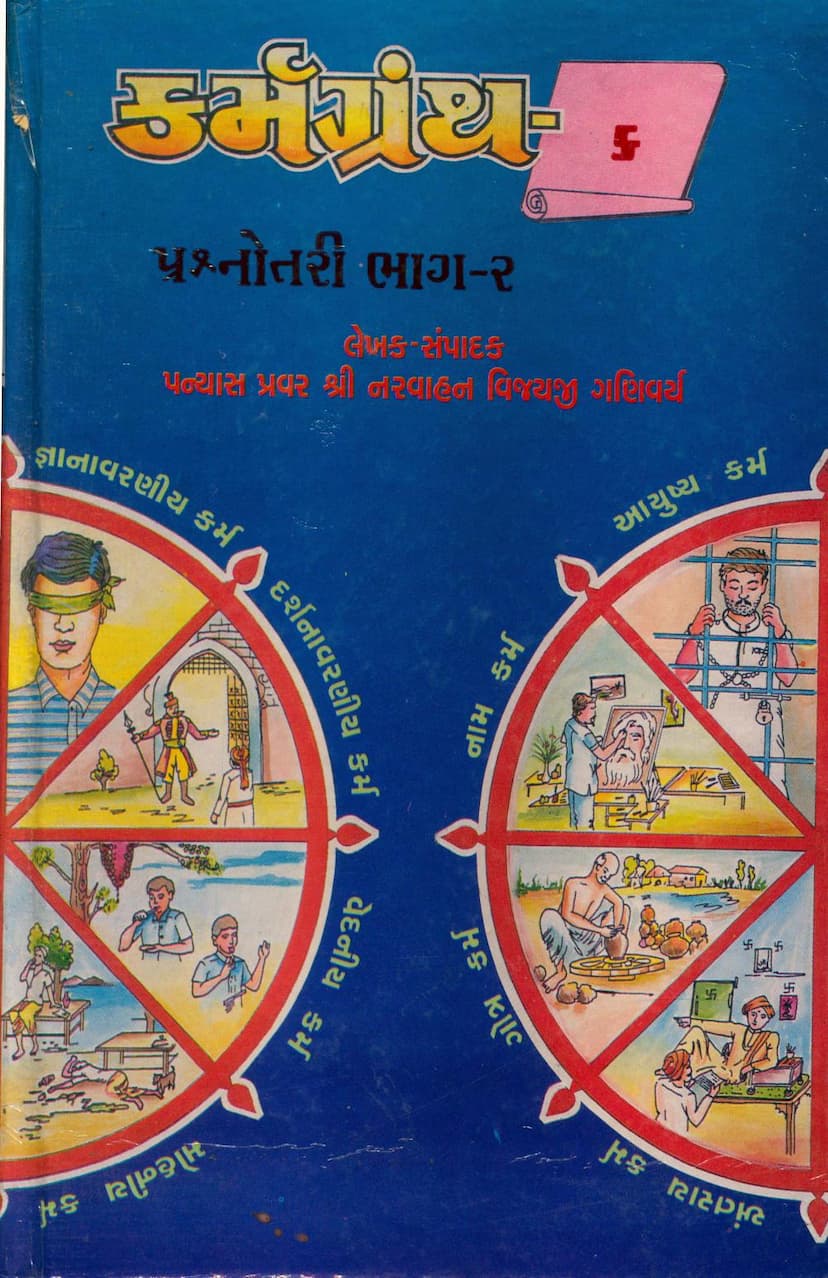Karmgranth 6 Prashnottari Part 02
Added to library: September 2, 2025

Summary
Here's a comprehensive summary of the Jain text "Karmgranth 6 Prashnottari Part 02" authored by Narvahanvijay and published by Padarth Darshan Trust, based on the provided text:
Book Title: Karmgranth 6 Prashnottari Part 02 (Karma Grantha-6: Question and Answer Section, Part 2)
Author/Editor: Pujya Panyas Pravar Shri Narvahan Vijayji Ganivarya. The text highlights his expertise in Karma literature and his discipleship under Acharya Devesh Shri Vijay Ramchandrasurishwarji Maharaj.
Publisher: Padarth Darshan Trust, Ashram Road, Ahmedabad.
Publication Details:
- Publication Number: 19
- Published in: Veer Samvat 2519 (1992 CE) / Sanvat 2011 Sharad Purnima
- Price: Rs. 40.00
Core Content: This book is the second part of an 8-part series on Karma Grantha, specifically focusing on the question-and-answer (Prashnottari) format to explain complex Jain philosophical concepts related to karma. The primary focus of this volume is the Mohaniya Karma (Deluding Karma).
Key Topics Covered:
- Mohaniya Karma (Deluding Karma): The book delves deeply into Mohaniya Karma, explaining its various aspects through a question-and-answer format.
- Bonding Places (Bandh Sthan): It details the various "bonding places" or conditions that lead to the formation of Mohaniya Karma, specifying the number of resulting karmic particles. For instance, it meticulously explains the 10 bonding places for Mohaniya Karma, starting from 22 particles down to 1 particle.
- Occurrence in Different Life Forms and Spiritual Stages: The text elaborates on how these bonding places manifest across different types of beings (Jiva Bhed) and spiritual progress stages (Gunasthanak). For example, it details which Jiva Bhed and Gunasthanak are associated with the bonding of 22 particles.
- Occurrence in Different Paths of Inquiry (Margana): It also explains how these karmic formations occur across various "paths of inquiry" or classifications (Margana), such as the 4 types of destinies (Gati), 5 types of births (Jati), 6 types of bodies (Kaya), 3 types of senses (Indriya), 3 types of minds (Yoga), etc.
- Stages of Causation and Manifestation: The book systematically breaks down the permutations and combinations of these karmic stages, linking them to specific conditions of existence and spiritual development.
- Number of Manifestations (Bandh, Uday, Sattha): A significant portion of the book is dedicated to detailing the number of "bonding places" (Bandh Sthan), "manifestation states" (Uday Sthan), and "subsistence states" (Sattha Sthan) for Mohaniya Karma. It lists the specific number of particles involved in each state and their relationships.
- Detailed Breakdown of Uday Sthans: A substantial section focuses on the 9 Uday Sthans of Mohaniya Karma, further detailing them into 42 specific variations (Vikalp). Each variation specifies the particular combination of karmic particles that are currently in a state of fruition.
- Detailed Breakdown of Bandh Bhaang (Combinations): The text meticulously explains the various "Bandh Bhaang" (combinations leading to karma bondage), especially for Mohaniya Karma. It categorizes these based on the number of karmic particles involved (e.g., 22 particles) and the contributing factors like different emotions (Rati, Arati) and genders (Purushved, Striveda).
- Specific Categorization by Jiva Bhed, Gunasthanak, and Margana: The majority of the questions and answers focus on precisely how many Jiva Bhed, Gunasthanak, and Margana are associated with each specific number of karmic particles in bondage, manifestation, or subsistence. This provides a highly detailed and technical explanation of karmic processes.
- Uday Bhaang (Manifestation Combinations): The book also details the combinations for Uday Bhaang, explaining how various karmic particles manifest in conjunction with different states of existence and spiritual stages.
- Sattā Sthans (Subsistence States): The latter part of the book delves into the 15 Sattha Sthans of Mohaniya Karma, detailing the specific karmic particles that can subsist in various states.
Overall Purpose: The book serves as a detailed guide, likely for scholars, monks, nuns, and serious lay followers of Jainism, to understand the intricate workings of Mohaniya Karma. It employs a systematic question-and-answer format to break down complex classifications and combinations of karmic states as per Jain philosophy. The emphasis is on providing a precise, numerical, and combinatorial understanding of how karma binds and manifests.
Important Note on Usage: Page 4 emphasizes a crucial directive: the use of knowledge materials (Jnan Dravya) should primarily be for preserving ancient manuscripts, maintaining knowledge repositories, and supporting the studies of monks and nuns. While laypeople (Shravak) are responsible for publishing such works, if knowledge funds are used, strict limitations must be observed. Books should be dedicated to Jain knowledge repositories, and if a householder wishes to acquire a book, they must pay the full price to the knowledge fund. The provided catalog link indicates this is for private and personal use only.
In essence, "Karmgranth 6 Prashnottari Part 02" is a highly specialized and technical Jain text that systematically explains the complex subject of Mohaniya Karma through detailed questions and answers, covering its bonding, manifestation, and subsistence states across various classifications of life and spiritual development.